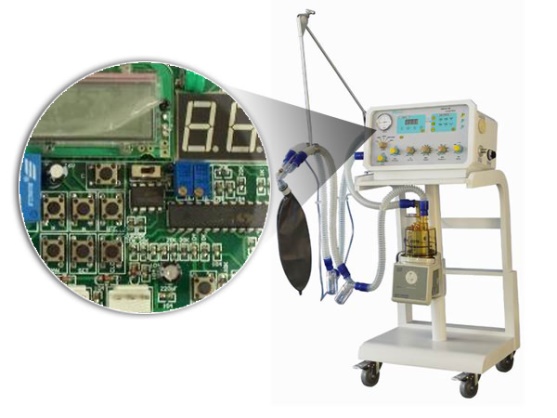
A ventilator is a device that can replace, control or change a person's normal physiological breathing, increase lung ventilation, improve respiratory function, reduce breathing work consumption, and save heart reserve capacity. The ventilator has four basic functions, that is, inflate the lungs, convert from inhalation to exhalation, discharge alveolar gas, and convert from exhalation to inhalation, and the cycle repeats in turn.
The ventilator is composed of air-oxygen mixer, breathing circuit, sensor, humidifier, safety gate, host, mixer, humidifier, air source and other components. Its working principle is that the negative pressure of the chest cavity is generated by the inhalation action during spontaneous ventilation, and the negative pressure of the alveoli and airway occurs when the lungs are passively expanded, thereby forming the pressure difference between the airway opening and the alveoli to complete the inhalation; after inhalation, the elasticity of the thorax and lungs Retraction creates an opposite pressure differential to complete exhalation. The ventilator ventilation is mechanically driven outside the body to generate a positive pressure difference between the airway opening and the alveoli, and exhalation is the passive positive pressure difference between the alveoli and the airway opening generated by the elastic retraction of the thorax and lungs after the external mechanical driving pressure is removed. That is, there is a "passive positive pressure difference" in the breathing cycle to complete the breathing.

Main types of ventilators
Constant pressure ventilator
When the constant-pressure ventilator is inhaling, the ventilator pumps a certain pressure of gas into the airway to expand the alveoli, and the airway pressure gradually rises. When the predetermined pressure is reached, the airflow stops and turns to the exhalation phase. The tidal volume of this type of ventilator is related to the preset pressure, inspiratory time, flow rate, etc. of the ventilator.
Constant volume ventilator ventilator
Constant-volume ventilator The ventilator pumps a fixed volume of gas into the patient's airway and lungs to produce inhalation and exhalation. The advantage of this type of ventilator is that it can guarantee a certain tidal volume in a closed airway state within a safe pressure range.
Timing ventilator
It is a timing, pressure-limiting and constant-flow ventilator. The ventilator generates airflow, enters the airway for a predetermined time, stops inhalation, and produces exhalation. During the expiratory phase, low-pressure airflow still passes through the airway. Its inspiratory time, respiratory rate, inspiratory/exhalation ratio, and inspiratory oxygen concentration can be adjusted.
The above classification is based on the transition between inspiratory and expiratory phases. There are also classifications according to control methods (electric, pneumatic) and uses. There is also a type of high-frequency ventilation ventilator, which is characterized by high breathing rate, low tidal volume, and non-closed air circuit operation.

Email:sales@sandchips.com
Address:ROOM 1, 16/F, EMPRESS PLAZA, 17-19 CHATHAM ROAD SOUTH, TSIM SHA TSUI, KOWLOON, HONG KONG